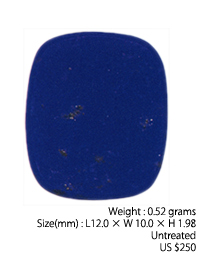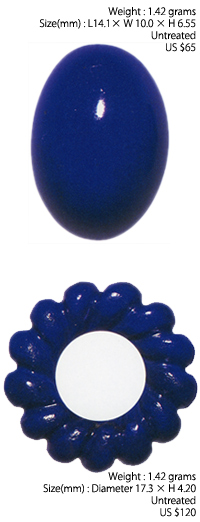CUTTING STYLES
Afghanistan is the main source of lapis lazuli, in terms of both quality and quantity. During the civil war of 1984, the Afghanistan government sold large quantities of lapis lazuli hit the Western markets, softening prices. Other sources of lapis lazuli are the Lake Baikal area in Siberia, Chile, and the United States. |
 |
Tablets
Lapis lazuli is cut into flat tablets, something seldom seen in turquoise, jadeite, or opal. Maximum beauty is achieved when this gemstone is fashioned into tablets, and many of these can be seen in men’s rings and cuff links. Taking into consideration the toughness of the material, polishing factories set the minimum thickness standard at 2.5 millimeters (0.10 inch). If cut any thinner than this, problems with durability arise, and it becomes difficult to cover the weight loss with the price. |
|
Cabochons
Many stones are seen fashioned as cabochons for use in rings and earrings. However, this cut is not used for material of exceptional quality. The finest lapis lazuli is fashioned into tablets or superb carvings, while the rough that is most often used for cabochons is of jewelry or accessory quality. Lapis lazuli is widely used in accessories. |
 |
Carvings
Ornaments and small articles carved from lapis lazuli are judged based on the quality of material and skill of workmanship. The degree of fineness of material can be determined by simply matching it to the squares in the chart to the next page. Instead of observing tone and beauty grade simultaneously, first determine the tone, and then judge the beauty grade to make a fairly accurate decision. |
|
 |
JUDGING QUALITY
When judging the quality of lapis lazuli tablets, one must first confirm whether or not the color is natural. Because dyeing will greatly affect value, it is extremely important to determine whether dye is present and to what extent. Manufacturers will test stones with acetone at the time of purchase. Continuously dealing with a trustworthy supplier is a basic guideline for procuring merchandise of consistent quality.
Second, check for a beautiful azure blue that is evenly distributed throughout the stone. Generally, a greenish cast will lower the beauty grade, while stones will a rich purplish blue color are considered most attractive. Setting aside material that is too light in tone, stones with medium darkness (tone 5) tent to be most desirable
Third, consider the presence of eye-visible inclusions of golden pyrite and white calcite. In this book, the finest stones are considered to be those of gem qualities with a solid azure blue, but stones with a well-balanced distribution of pyrite can be graded to reflect the presence of many buyers. Calcite detracts from beauty, and material that contains it is always assigned low beauty grade. |
| |
|